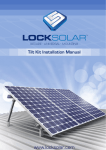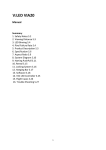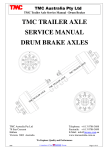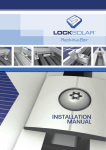Download INSTALLATION MANUAL
Transcript
TM Rack-in-a-Box TM INSTALLATION MANUAL TM TM Rack-in-a-Box 1.0 INTRODUCTION 2.0 PRODUCT RANGE 2.1 Rack-in-a-Box Systems 2.2 Accessories 3.0 PREPARATION FOR INSTALLATION 3.1 Applications 3.2 Tools for Installation 3.3 Additional Materials for Installation 4.0 PLANNING THE INSTALLATION 4.1 Site Locations 4.2 Installation Height 4.3 Solar Panel Layout 4.4 General Installation Notes 5.0 INSTALLATION 5.1 Tin Roof (L-Bracket) Installation 5.2 Tile Roof (Tile Hook) Installation 5.3 Mounting Rail Installation 5.4 Joining Mounting Rails (Rail Joiner) 5.5 Cable Management Features 5.5.1 Integrated Cable Track 5.5.2 Twist Lock Cable Ties 5.6 Solar Panel Installation 5.7 End Clamps 5.8 Mid Clamps 6.0 SYSTEM COMPONENTS 7.0 STANDARDS 8.0 CONTACT DETAILS 3 4 4 4 5 5 5 5 6 6 7 7 8 9 9 10 11 12 13 13 14 14 15 16 17 19 19 TM TM Rack-in-a-Box 1.0 INTRODUCTION Thank you for choosing LOCK SOLAR for your solar panel installation. The LOCK SOLAR, Rack-in-a-BoxTM has been designed specifically for Australian conditions and uses the highest quality materials in the construction. The Rack-in-a-BoxTM system provides you with unequalled security for your valuable solar investment. The Rack-in-a-BoxTM can be used in rural areas, on hill side and hill top sites and in cyclonic regions within Australia by including additional roof brackets in the installation. These additional brackets come in Rack-in-a-BoxTM – Additional Mounting kits to suit. The Rack-in-a-BoxTM is compliant with the structural design requirements of Australian / New Zealand standard AS 1170.2 and comes with a 12 year warranty. WARNING INSTALLATION OF THE RACK-IN-A-BOXTM SYSTEM IS INTENDED TO BE PERFORMED BY PROFESSIONALLY TRAINED INSTALLERS ONLY. ANY ATTEMPT TO INSTALL THE THE RACK-IN-A-BOXTM SYSTEM BY AN UNQUALIFIED INDIVIDUAL COULD RESULT IN INJURY OR DEATH The installer is solely responsible for: • Complying with all applicable local and national building codes; • Ensuring that the Rack-in-a-BoxTM and other products used in the installation are appropriate for the particular installation and the installation environment; • Ensuring that the roof structure, its rafters, connections and other structural support members can withstand the installation of the Rack-in-a-BoxTM and solar panel modules under live building load conditions; • Ensuring only Rack-in-a-BoxTM parts are used in the installation. Substitution of parts could lead to a failure in the Rack-in-a-BoxTM system; • Ensuring that the roof attachments of the roof mounting brackets have sufficient pullout and shear capacities as installed; • Maintaining the watertight integrity of the roof; • Ensuring safe installation of all components of the system • Verifying that other loading factors including water, ice, snow and seismic loads do not affect the installation. TM TM Rack-in-a-Box 2.0 PRODUCT RANGE The Rack-in-a-BoxTM system comes conveniently packaged in a box starting from 3 and 4 panel installations. All the components you need to successfully install your system, in most metropolitan and regional areas, are included. 2.1 Rack-in-a-Box Systems The Rack-in-a-BoxTM system is available in modular kits to suit both 3 and 4 panel installations and to suit either tin or tile roofs. Each kit comes with 2 rails and enough mounting components to suit most applications. Additional mounting kits to suit high wind/cyclonic regions are available for purchase as accessories. Product Code Description Rail Length (mm) RIB-2560-3MTN RIB-2560-3MTL RIB-3410-4MTN RIB-3410-4MTL Rack-in-a-BoxTM – 2560mm, Tin Roof Kit Rack-in-a-BoxTM – 2560mm, Tile Roof Kit Rack-in-a-BoxTM – 3410mm, Tin Roof Kit Rack-in-a-BoxTM – 3410mm, Tile Roof Kit 2560 2560 3410 3410 2.2 Accessories Product Code Description RIB-ADD-TN RIB-ADD-TL RIB-CT RIB-3410-4MTL Rack-in-a-BoxTM – Additional Mounting Kit, Tin Roof * Rack-in-a-BoxTM – Additional Mounting Kit, Tile Roof * Rack-in-a-BoxTM – Additional Clip-in Cable Loop Tie Kit Rack-in-a-BoxTM – 3410mm, Tile Roof Kit * As recommended for high structural requirements such as: cyclonic / high wind regions, terrain, or topographic factors TM TM Rack-in-a-Box 3.0 PREPARATION FOR INSTALLATION 3.1 Applications Rack-in-a-BoxTM is designed for installation on residential and commercial buildings in standard, marine or remote areas. Rack-in-a-BoxTM is designed for mounting solar panel modules to flat or pitched, tin or tile roofs. 3.2 Tools for Installation You will need the following tools for installing the Rack-in-a-BoxTM system. 1. 2. 3. 4. 5. Cordless drill Grinder with stone disk (for tile roof installation only) Protective gloves and clothing Security driver Various wood screw drivers, including Phillips head driver and Torx head drivers 3.3 Additional Materials for Installation Rack-in-a-BoxTM comes with just about everything you need to install the solar module panels, however in order to ensure the watertight integrity of the roof you will need waterproofing materials. Other tools and materials may be required to ready the roof structure for installation. TM TM Rack-in-a-Box 4.0 PLANNING THE INSTALLATION Rack-in-a-BoxTM has been configured to meet a large percentage of common installation sites around Australia. Additional components are available to extend the performance of the system to suit unusual sites and installations. These consist of additional roof brackets / tile brackets that are used to hold the installation to the roof structure. Please consult your Rack-in-a-BoxTM distributor for assistance in these situations. 4.1 Site Locations Locations in Australia are subject to different wind structural loadings in accordance with the requirements identified in AS 1170.2 Rack-in-a-BoxTM has been designed to be installed in most areas in Australia where installations are located in Regions A and B. These areas include all major city and suburban regions of Sydney, Melbourne, Brisbane, Adelaide, Canberra, Hobart and Perth. See figure 1 for wind areas. The terrain surrounding the installation has a major impact on the wind loadings that the installation must withstand. If you are intending to use Rack-in-a-BoxTM in Cyclonic regions identified as Region C and D then you will need to purchase Rackin-a-BoxTM Additional Mounting kits to be used in the installation. Please contact your Rack-in-a-BoxTM distributor for more information. Figure 1 - Wind Regions - Australia AS 1170 If you are intending to use the Rack-in-a-BoxTM in Cyclonic regions identified as Region C and D, then you will need to purchase Rack-in-a-BoxTM – Additional Mounting kits to be used in the installation. Please contact your Rack-in-a-BoxTM distributor for more information. The terrain surrounding the installation has a major impact on the wind loadings that the installation must withstand. The Rack-in-a-BoxTM system can be used in rural locations but in some cases may require you to purchase Rack-in-a-BoxTM – Additional Mounting kits to be used in the installation. Please contact your Rack-in-a-BoxTM distributor for more information. TM TM Rack-in-a-Box 4.2 Installation Height Rack-in-a-BoxTM has been designed specifically for single storey and two storey buildings, up to a maximum height of 10 metres above ground. If you are intending to use Rack-in-a-BoxTM for installations higher than 10 metres above ground level, then you may need to purchase Rack-in-a-BoxTM – Additional Mounting kits to be used in the installation. Please contact your Rack-in-a-BoxTM distributor for more information. 4.3 Solar Panel Layout Rack-in-a-BoxTM is a modular system to which a range of solar panel modules can be mounted. Rack-in-a-BoxTM clamps the solar panel modules to parallel rails that are aligned with and tied structurally to the existing roof structure. Rack-in-a-BoxTM needs to be sited within the perimeter of the roof and no closer to the roof edges than as follows; An Array that will locate the solar panel modules closer to the roof edges will require engineering verification. Please consult your Rack-in-a-BoxTM distributor for further information. Figure 2 – Installation Perimeter Zones Distance A (edge of panel to roof perimeter) must be a minimum of 20% of X and 20% of installation height Distance B (edge of panel to roof perimeter) must be a minimum of 20% of Y and 20% of installation height Layouts that will locate the solar panel modules closer to the roof edges will require engineering verification. Please consult your Rack-in-a-BoxTM distributor for further information. 4.4 General Installation Notes 1. Mounting rails should align with the spacing of the battens/purlins of the roof. 2. The spacing between the mounting rails shall not be less than 50% of the length of the solar panel modules. 3. The mounting brackets (L-Brackets or Tile Hooks) should align with the rafters of the roof structure. 4. The mounting brackets (L-Brackets or Tile Hooks) shall be spaced evenly along the length of the mounting rail. 5. The outer most mounting brackets (L-Brackets or Tile Hooks) shall be located within 200mm of the rail ends. TM TM Rack-in-a-Box 5.0 INSTALLATION When referring to the layout of the solar panel modules and the Rack-in-a-BoxTM system, identify the positions of the mounting rails and locate the roof structure for attachment. 5.1 Steel Roof L-Bracket Installation The mounting rails are attached to the roof structure through the roof sheeting. Assembly steps 1. Mark the installation points and ensure that installation points are located over the centre of the rafters. 2. Drill pilot holes in the tin roofing for the roofing screw. 3. Use the rubber pad supplied in the Rack-in-a-BoxTM kit under each bracket and over the pilot hole to ensure a watertight connection. 4. Align the bracket along the line of the mounting rail with the upright towards the top of the roof. 5. Secure the bracket with the roofing screw. TM TM Rack-in-a-Box 5.2 Tile Roof Tile Hook Installation The mounting rails are attached to the roof structure using the tile hooks. Modifications to tiles are required where the tile hooks will be placed. Assembly steps 1. Mark the installation points over the centre of the rafters. 2. Remove the tile from the roof. 3. Locate the position of the tile hook such that the tile hook lies in the valley of the lower tile. Ensure that the tile hook is located against the up slope edge of the lower tile. 4. The tile hook must mount flush to the rafters and lay flat along the valley face of the lower tile. Use the shims provided to ensure the best fit. 5. Mount the tile hook to the exposed rafter using the supplied wood screws. Use at least 3 wood screws per tile hook. 6. When replacing the tile, the tile hook must lie flat against the lower tiles. If necessary, cut recesses into the inner face of the tile to accommodate the tile hook and ensure best watertight fit. TM TM Rack-in-a-Box 5.3 Mounting Rail Installation All Rack-in-a-BoxTM systems arrive with the L-Brackets and Tile-Hooks pre-assembled with the mounting rail attachments, in order to save you installation time. Assembly steps; 1. Attach the mounting rail to the roof brackets as shown. 2. Make sure that the ridged side of the rail corresponds with the ridges on the mounting bracket. 3. Position the mounting rail at the desired height on each of the brackets then align the ends of the rail and tighten the rail to the brackets – Apply a torque of 8Nm to the bolt. TM TM Rack-in-a-Box 5.4 Joining Mounting Rails In circumstances where large arrays of solar panels are being installed, Rack-in-a-BoxTM provides a means for joining mounting rails. The rail joiner does not replace the need for the roofing brackets. Roof mounting brackets must be attached on either side of the joint, within a distance of 200mm. The joint for the mounting rail does not replace the need for the roof attachment brackets. Roof mounting brackets must be located either side of the joint within a distance of 200 mm. Assembly steps 1. The joiner comes preassembled with fasteners for your convenience. 2. Assemble the joiner to the mounting rails. Ensure that the joiner spans the joint equally and the bolts are located either side of the joint. 3. Tighten the bolts. Torque the bolts to 8 Nm. TM TM Rack-in-a-Box 5.5 Cable Management Features Rack-in-a-BoxTM incorporates a number of cable management features; 5.5.1 Integrated Cable Track Assembly steps 1. Push loose cable into integrated cable slot Note: Integrated cable slot will accommodate 2 to 3 cables. TM TM Rack-in-a-Box 5.5.2 Twist Lock Cable Ties Assembly steps 1. Position cable tie so that it runs parallel to rail and insert boss into rail clipping groove. 2. Maintaining some pressure, rotate clip clockwise to vertical locked position. 3. Collect excess cable into loops and bend cable tie tail up to hold in place. 4. Push cable tie tail through ratchet head and pull to tighten. 5.6 Solar Panel Module Installation WARNING ENSURE YOU FOLLOW ANY OF THE RECOMMENDATIONS AND INSTRUCTIONS OF THE SOLAR PANEL MODULE SUPPLIER IN HANDLING AND INSTALLING THE SOLAR PANEL MODULE. FOLLOW THE NEXT INSTRUCTIONS CAREFULLY. WHEN INSTALLING THE PANELS CORRECTLY USING THE RACK-IN-A-BOXTM SYSTEM THE SOLAR PANEL MODULES WILL NOT BE DAMAGED. Ensure the solar panels are assembled to the Rack-in-a-BoxTM mounting rails one panel at a time. Use a suitable means to prevent the panels slipping from the frame during installation. Once installed, the mounting clamps will hold the solar panels in place. Until the clamps are securely installed, the solar panels need to be appropriately secured. TM TM Rack-in-a-Box 5.7 End Clamps Assembly steps 1. Determine the thickness of your solar panel module. 2. Start by assembling the 1st set of end clamps on each of the mounting rails. The end clamps are designed to suit a variety of solar panel thicknesses - from 35mm to 55mm. Set the end clamp to the required height. 3. The end clamps come preassembled with the fasteners for your convenience. 4. Attach the end clamp to the mounting rail. 5. Tighten the end clamp firmly against the solar panel, applying a torque of 8Nm. TM TM Rack-in-a-Box 5.8 Mid Clamps Assembly steps (for solar module thickness of 35mm to 45mm): 1. The mid clamps are preassembled with the fasteners for your convenience. 2. Attach the mid clamp to the mounting rail. 3. Position the mid clamp firmly against the edge of the solar panel. 4. Turn the bolt to achieve a loose fit. 5. Slide the adjoining solar panel along the rail and under the mid clamp. 6. Ensure that the mid clamp is tight against the solar modules. 7. Tighten the bolt, applying a torque of 8Nm. Assembly steps (for solar module thickness of 45mm to 55mm): 1. Disassemble the fasteners from the mid clamp assembly and remove the aluminium spacer tube from around the bolt. 2. Reassemble the fasteners to the mid clamp. 3. Attach the mid clamp to the mounting rail. 4. Position the mid clamp firmly against the edge of the solar panel. 5. Turn the bolt to achieve a loose fit. 6. Slide the adjoining solar panel along the rail and under the mid clamp. 7. Ensure that the mid clamp is tight against the solar modules. 8. Tighten the bolt, applying a torque of 8Nm. TM TM Rack-in-a-Box 6.0 SYSTEM COMPONENTS Mounting Rail Tile Hook End Clamp Roofing Screw Mid Clamp Twist Lock Cable Tie Rail Joiner L Bracket Security Head Screw TM TM Rack-in-a-Box 7.0 STANDARDS Australian/New Zealand Wind Loading Standard AS/NZS1170.2.2002. Wind load testing performed under AS4040.2-1992. TM Rack-in-a-Box TM Secure • Versatile • Mounting 8.0 CONTACT DETAILS T: 1300 199 233 F: 1300 779 882 INT: +61 41 99 22 777 E: [email protected] www.locksolar.com

























